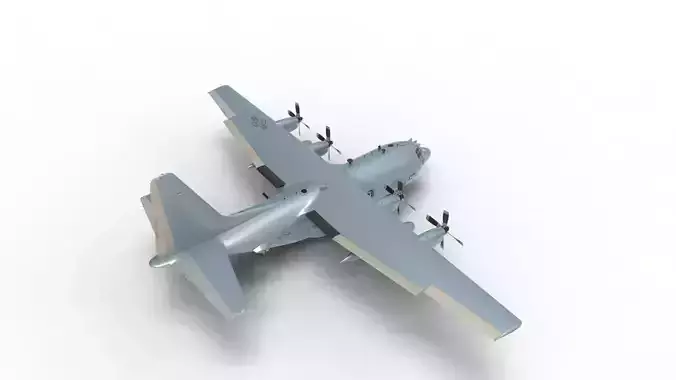1/10
The Lockheed C-130 Hercules is an American four-engine turboprop military transport aircraft designed and built originally by Lockheed (now Lockheed Martin). Capable of using unprepared runways for takeoffs and landings, the C-130 was originally designed as a troop, medevac, and cargo transport aircraft. The versatile airframe has found uses in a variety of other roles, including as a gunship (AC-130), for airborne assault, search and rescue, scientific research support, weather reconnaissance, aerial refueling, maritime patrol, and aerial firefighting. It is now the main tactical airlifter for many military forces worldwide. More than 40 variants of the Hercules, including civilian versions marketed as the Lockheed L-100, operate in more than 60 nations.
The C-130 entered service with the U.S. in 1956, followed by Australia and many other nations. During its years of service, the Hercules family has participated in numerous military, civilian and humanitarian aid operations. In 2007, the C-130 became the fifth aircraft[N 1] to mark 50 years of continuous service with its original primary customer, which for the C-130 is the United States Air Force. The C-130 Hercules is the longest continuously produced military aircraft at over 60 years, with the updated Lockheed Martin C-130J Super Hercules currently being produced.Design phaseThe Hercules resembled a larger four-engine version of the C-123 Provider with a similar wing and cargo ramp layout that evolved from the Chase XCG-20 Avitruc, which in turn, was first designed and flown as a cargo glider in 1947.[5] The Boeing C-97 Stratofreighter had rear ramps, which made it possible to drive vehicles onto the airplane (also possible with forward ramp on a C-124). The ramp on the Hercules was also used to airdrop cargo, which included a Low-altitude parachute-extraction system for Sheridan tanks and even dropping large improvised daisy cutter bombs. The new Lockheed cargo plane had a range of 1,100 nmi (1,270 mi; 2,040 km) and it could operate from short and unprepared strips.
Fairchild, North American, Martin, and Northrop declined to participate. The remaining five companies tendered a total of ten designs: Lockheed two, Boeing one, Chase three, Douglas three, and Airlifts Inc. one. The contest was a close affair between the lighter of the two Lockheed (preliminary project designation L-206) proposals and a four-turboprop Douglas design.
The Lockheed design team was led by Willis Hawkins, starting with a 130-page proposal for the Lockheed L-206.[6] Hall Hibbard, Lockheed vice president and chief engineer, saw the proposal and directed it to Kelly Johnson, who did not care for the low-speed, unarmed aircraft, and remarked, If you sign that letter, you will destroy the Lockheed Company.[6] Both Hibbard and Johnson signed the proposal and the company won the contract for the now-designated Model 82 on 2 July 1951.[7]
C-130 Hercules flight deck. Aircraft displayed at the Norwegian Armed Forces Aircraft CollectionThe first flight of the YC-130 prototype was made on 23 August 1954 from the Lockheed plant in Burbank, California. The aircraft, serial number 53-3397, was the second prototype, but the first of the two to fly. The YC-130 was piloted by Stanley Beltz and Roy Wimmer on its 61-minute flight to Edwards Air Force Base; Jack Real and Dick Stanton served as flight engineers. Kelly Johnson flew chase in a Lockheed P2V Neptune.[8]
After the two prototypes were completed, production began in Marietta, Georgia, where over 2,300 C-130s have been built through 2009.[9]
The initial production model, the C-130A, was powered by Allison T56-A-9 turboprops with three-blade propellers and originally equipped with the blunt nose of the prototypes. Deliveries began in December 1956, continuing until the introduction of the C-130B model in 1959. Some A-models were equipped with skis and re-designated C-130D. As the C-130A became operational with Tactical Air Command (TAC), the C-130's lack of range became apparent and additional fuel capacity was added with wing pylon-mounted tanks outboard of the engines; this added 6,000 lb (2,720 kg) of fuel capacity for a total capacity of 40,000 lb (18,140 kg)
REVIEWS & COMMENTS
accuracy, and usability.










